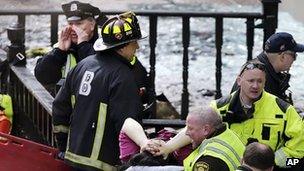Boston Marathon attack: How secure are marathons?
- Published

An analyst praised the co-ordination between first responders in the explosions' aftermath
Despite the diligent efforts of security officials, marathons are among the toughest sport events to secure, analysts say.
The Boston Marathon is one of America's premier sporting events.
But with 26.2 miles coursing through Boston's suburbs and crowded centre, it is also one of the hardest to keep safe.
"It's an outdoor event with no access control: 26 miles of open-ended opportunities for people to come in and out," says Lou Marciani, director of the National Center for Spectator Sports Safety and Security at the University of Southern Mississippi.
"There is no good way to secure a finish line," tweeted, external Juliette Kayyem, former head of homeland security for Massachusetts Governor Deval Patrick, who worked security for the marathon in the past.
Aware of the challenge, marathon organisers undertake massive security preparations ahead of a race.
Long before the starting gun, organisers hold planning sessions, form an incident response team, and drill for emergencies.
"Everyone has a place at the table, whether it's fire, emergency management, law enforcement, venue operations, or city authorities," says Mr Marciani. "All get together many, many times before the event."
The fruits of those efforts were on display today, he says.
"The response has been outstanding," he says, noting the co-ordination between federal, state and local authorities.
Since 9/11, Mr Marciani says, the National Center for Spectator Sports Safety and Security has worked with more than 9,000 emergency responders and 900 universities and sport venues to ensure "seamless" security.
A large part of the security strategy focuses on keeping out those who may pose a threat.
"It's about access control," he says. "You need to have some control of who's coming in."
That is much easier at stadiums and enclosed venues, where security officials can check bags and scan spectators for dangerous devices. But it is much more difficult at open-air marathons.
"Someone can walk up in the middle of the marathon disguised as a runner or a spectator, and we have no way of knowing," Mr Marciani says.
"In a smaller area we have capabilities for dog sniffing for IEDs. We have to look at more sensor-related tech to detect any explosives. That's the direction I would like to see us go into, to look at technology to cover a greater landscape."
The most common security hazards are "bandit" runners who jump on the course without registering - or racers who take shortcuts, and for the most part, mass violence at sporting events is exceptionally rare across the world.
"They are really few and far between," says Alana Penza, director of the Institute for Sports Incidents.
"Even in other countries, it's small little flares going up."
Before Monday's attack in Boston, there had been only two such events in US history.
In 1996 two people were killed and 111 injured when an anti-abortion militant detonated three pipe bombs at the Atlanta Olympics. In 2005, a suicide bomber killed himself - but no one else - in close proximity to a student football game at the University of Oklahoma.
Mr Marciani says the Boston explosions will be analysed extensively at the National Sports Safety and Security Conference and Exhibition this July.
"This will expand our idea of what a venue means," he says.
For runners, the security lessons cannot be learned soon enough.
"It's all so overwhelming," a runner told the Boston Globe, external. "You assume there's high security, but the course is so long that I guess it's impossible to guard against everything."
- Published16 April 2013
- Published16 April 2013
- Published17 April 2013
- Published16 April 2013
- Published15 April 2013